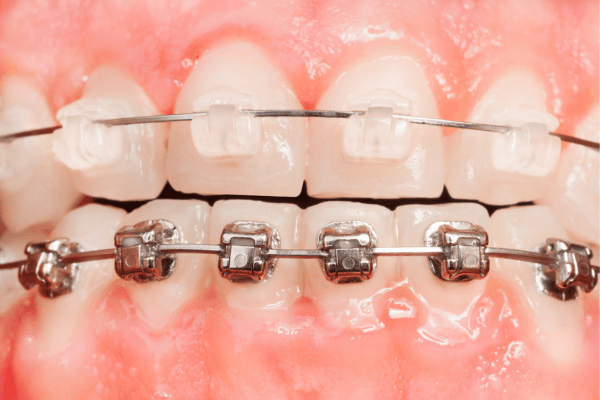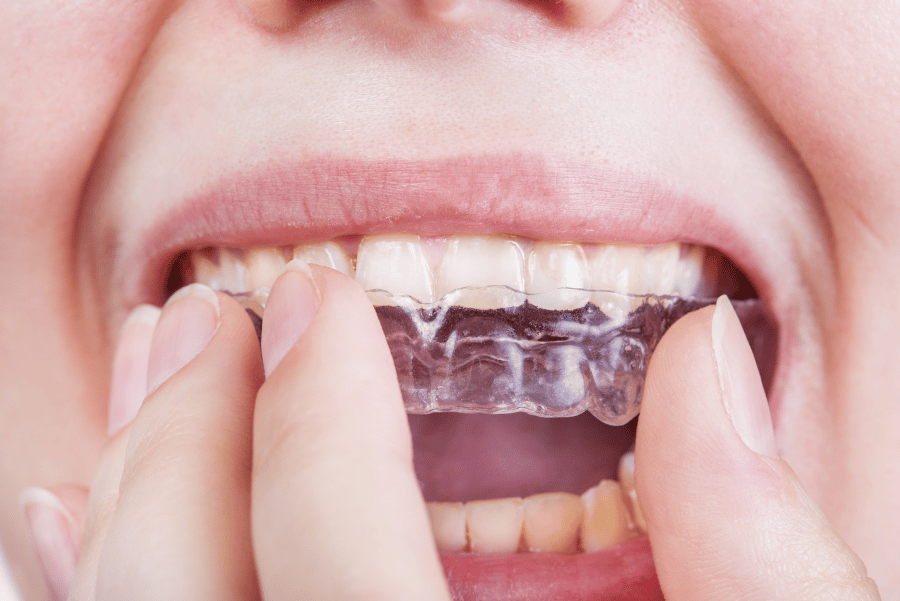For people seeking orthodontic treatments, the debate between clear aligners and traditional braces is a hot topic. Both options have their advantages and disadvantages, but which is the better choice for you this year? This blog will explore the key differences, including the clear aligners vs braces cost and the overall effectiveness of braces vs clear aligners, to help you make an informed decision.
Understanding Clear Aligners and Braces
Before diving into the comparison, let’s understand what each option entails. Clear aligners are nearly invisible trays made of a plastic material, designed to fit snugly over your teeth and gently move them into the desired position over time. Popularized by brands like Invisalign, clear aligners have become a favorite for adults and teens who want a less noticeable orthodontic treatment.
On the other hand, traditional braces consist of metal brackets glued to the teeth, connected by wires that are periodically tightened by an orthodontist to shift teeth into place. They have been around for decades and are known for their effectiveness in treating a wide range of dental misalignments.
Types of Braces Available
Braces technology has significantly advanced, offering various options tailored to meet individual needs and preferences. Below, we detail the main types of braces available today, including approximate pricing for each, to help guide your decision.
Metal Braces
Metal braces are the classic and most common type, made from high-grade stainless steel. They are known for their durability and effectiveness in treating a wide range of orthodontic issues. Modern metal braces are smaller and more comfortable than older versions, and patients can personalize their appearance with colored bands. Approximate pricing: $3,000 to $7,000, making them one of the most affordable options.

Ceramic Braces
Ceramic braces offer a less noticeable alternative, using brackets that are either clear or tooth-colored to blend in with the teeth. While they provide the same effectiveness as metal braces, ceramic braces are preferred for their aesthetic appeal. They do, however, require more careful maintenance to avoid staining. Approximate pricing: $4,000 to $8,000, slightly higher than metal braces due to the materials used.
Lingual Braces
Lingual braces are custom-fitted to the back side of the teeth, making them invisible from the front. They are ideal for those concerned about the visibility of their orthodontic treatment. Lingual braces can be more challenging to clean and may initially cause discomfort to the tongue. Approximate pricing: $8,000 to $10,000, reflecting their customization and placement complexity.
Self-ligating Braces
Self-ligating braces utilize a specialized clip in place of elastics to hold the archwire, reducing the amount of pressure exerted on the teeth and potentially shortening treatment time. These braces come in both metal and ceramic varieties and are known for requiring fewer dental visits. Approximate pricing: $3,000 to $8,000, varying by the type of material and specific brand used.
Clear and Removable Aligners
Clear aligners are an alternative to traditional braces, using a series of custom, clear plastic trays to gradually shift teeth into place. They are virtually invisible and can be removed for eating, drinking, and oral hygiene. Clear aligners are suitable for mild to moderate alignment corrections. Approximate pricing: $1500 to $8,000, similar to the cost of traditional braces but can vary widely based on treatment complexity and duration.

| Type of Braces | Appearance | Approx Pricing |
|---|---|---|
| Metal Braces | Visible, metallic | $3,000 to $7,000 |
| Ceramic Braces | Less visible, tooth-colored | $4,000 to $8,000 |
| Lingual Braces | Invisible from front | $8,000 to $10,000 |
| Self-ligating Braces | Similar to metal/ceramic | $3,000 to $8,000 |
| Clear Aligners | Nearly invisible | $1500 to $8,000 |
Braces vs Clear Aligners: A Detailed Comparison
When comparing braces vs clear aligners, several factors come into play, including appearance, cost, treatment time, and effectiveness for complex dental issues.
Appearance
One of the most significant advantages of clear aligners is their nearly invisible appearance, making them a more attractive option for those who are self-conscious about wearing braces. Traditional braces, with their metal brackets and wires, are more noticeable.
Cost
The clear aligners vs braces cost is a crucial consideration for many. There are many affordable brands for clear aligners like ALIGNERCO, Byte and Aligner32 with pricing starting from $1100. The cost for braces varies depending on the complexity of the case and the duration of the treatment starting from $4000 to $8000. Read our detailed blog on The Most Economical Clear Aligners to find affordable clear aligners.
Treatment Time
Treatment time can vary widely depending on the individual’s dental issues. Clear aligners often promise shorter treatment times compared to traditional braces, but this is not guaranteed for every case. The effectiveness of clear aligners also depends on the patient wearing them for the recommended 20-22 hours a day.
Effectiveness for Complex Dental Issues
Traditional braces are typically more effective for complex dental issues, such as severe overcrowding, gaps, or bite problems. Clear aligners are continually improving, but there are still limitations to what they can achieve, especially for more complex orthodontic cases.
| Feature | Braces | Clear Aligners |
|---|---|---|
| Appearance | Visible metal brackets and wires | Nearly invisible, made of clear plastic |
| Comfort | Can cause discomfort and irritation to cheeks and lips | Smooth edges, generally considered more comfortable |
| Convenience | Requires regular adjustments at the orthodontist’s office | Removable for eating and oral hygiene |
| Treatment Time | Typically 18-24 months, but varies by case | Average 12-18 months, but varies by case |
| Effectiveness | Effective for a wide range of orthodontic issues, including complex cases | Best for mild to moderate alignment issues, with improvements for more complex cases |
| Lifestyle Impact | Dietary restrictions to avoid damaging braces; more challenging oral hygiene | No dietary restrictions; easier oral hygiene due to removability |
| Approx Pricing | $4,000 – $8,000 | $1500 – $8,000 |
Making the Right Choice for Your Smile
Deciding between clear aligners and traditional braces is a significant step in your journey to achieving the perfect smile. This choice should be based on a comprehensive evaluation of your individual dental needs, aesthetic preferences, and lifestyle considerations. While both options have their advantages, clear aligners are increasingly becoming the preferred choice for those seeking a balance between effectiveness and discretion in their treatment.

“It is important to consult a qualified orthodontist for a thorough evaluation and for a personalized treatment plan. Professional orthodontic care ensures that your teeth straightening journey is safe, effective, and tailored to your unique needs.” -Dr. Athar
The Aesthetic Advantage of Clear Aligners
In today’s world, where appearance and first impressions hold considerable weight, the nearly invisible nature of clear aligners stands out as a substantial benefit. Unlike traditional braces, which are often associated with a metallic smile, clear aligners offer a level of discretion that is hard to match. This feature makes them an especially attractive option for adults and teenagers who might feel self-conscious about undergoing orthodontic treatment. With clear aligners, you can continue to smile confidently, knowing that your path to straighter teeth is your secret to keep.
Consult with a Professional for Personalized Advice
The journey to a perfect smile is unique for everyone, which is why consulting with an orthodontist is a crucial step. Orthodontists are well-equipped to evaluate your dental condition in detail and can provide expert advice on whether clear aligners or traditional braces are better suited to your needs. They consider various factors, including the severity of misalignment, the presence of bite issues, and the overall health of your teeth and gums. By seeking professional guidance, you ensure that your decision is informed and tailored to achieve the best possible outcome for your smile.
Lifestyle Considerations: Flexibility and Comfort
When it comes to integrating orthodontic treatment into your daily life, clear aligners offer unparalleled flexibility and comfort. Designed for a modern lifestyle, clear aligners can be removed during meals, allowing you to enjoy your favorite foods without restrictions. This removability also simplifies your oral hygiene routine, making it easier to maintain healthy teeth and gums throughout your treatment. Moreover, clear aligners are known for their comfort, with smooth edges that minimize irritation to your mouth, a common complaint among those who choose traditional braces. For individuals leading active, social, or professional lives, clear aligners provide a convenient solution that aligns with their dynamic lifestyle requirements.
Discreet and Effective Treatment
The choice of clear aligners reflects a desire for a treatment that is not only effective but also aligns with the demands of contemporary life. The benefits of clear aligners extend beyond their aesthetic appeal, offering a blend of effectiveness, comfort, and convenience that traditional braces struggle to match. As innovations continue to enhance their capabilities, clear aligners are becoming a viable option for an increasingly wide range of dental issues, including some that were once thought to be the exclusive domain of traditional braces.
Conclusion
The debate between clear aligners vs braces doesn’t have a one-size-fits-all answer. Each option has its pros and cons, and the right choice depends on your personal needs, lifestyle, and the complexity of your dental issues. By considering the factors outlined above and consulting with a professional, you can make an informed decision that will lead you to your best smile this year.
FAQs
1. Which works better, clear aligners or braces?
Effectiveness depends on your dental needs. Braces are better for complex issues, while clear aligners are suitable for mild to moderate cases. Consult an orthodontist for personalized advice. An in-depth evaluation is crucial to determine the right treatment for achieving the best results.
2. Are clear aligners more costly than braces?
Costs are comparable, ranging from $3,000 to $8,000 for both. Prices vary by case complexity and location. Check with an orthodontist for a detailed quote. Some insurance plans may cover a portion of the treatment, affecting the overall cost.
3. How long is treatment with clear aligners vs. braces?
Clear aligners usually take 12-18 months, shorter than braces, which may take 18-24 months. Treatment times vary by individual needs and adherence to the treatment plan. Consistency in wearing clear aligners as prescribed is key to staying on schedule.
4. Can I eat normally with clear aligners?
Yes, clear aligners are removable for eating, allowing no dietary restrictions. It’s important to clean your teeth and aligners before reinserting after meals. This flexibility is a significant advantage over traditional braces, enhancing comfort and ease during treatment.
